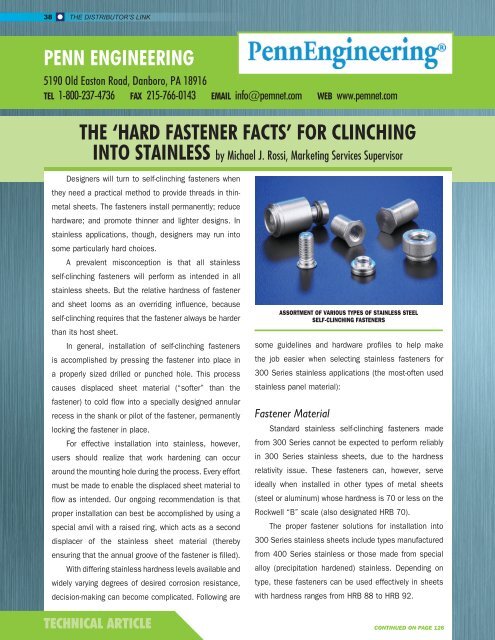SPRING 2018
Distributor's Link Magazine Spring 2018 / Vol 41 No2
Distributor's Link Magazine Spring 2018 / Vol 41 No2
Create successful ePaper yourself
Turn your PDF publications into a flip-book with our unique Google optimized e-Paper software.
38<br />
THE DISTRIBUTOR’S LINK<br />
PENN ENGINEERING<br />
5190 Old Easton Road, Danboro, PA 18916<br />
TEL 1-800-237-4736 FAX 215-766-0143 EMAIL info@pemnet.com WEB www.pemnet.com<br />
THE ‘HARD FASTENER FACTS’ FOR CLINCHING<br />
INTO STAINLESS by Michael J. Rossi, Marketing Services Supervisor<br />
Designers will turn to self-clinching fasteners when<br />
they need a practical method to provide threads in thinmetal<br />
sheets. The fasteners install permanently; reduce<br />
hardware; and promote thinner and lighter designs. In<br />
stainless applications, though, designers may run into<br />
some particularly hard choices.<br />
A prevalent misconception is that all stainless<br />
self-clinching fasteners will perform as intended in all<br />
stainless sheets. But the relative hardness of fastener<br />
and sheet looms as an overriding influence, because<br />
self-clinching requires that the fastener always be harder<br />
than its host sheet.<br />
In general, installation of self-clinching fasteners<br />
is accomplished by pressing the fastener into place in<br />
a properly sized drilled or punched hole. This process<br />
causes displaced sheet material (“softer” than the<br />
fastener) to cold flow into a specially designed annular<br />
recess in the shank or pilot of the fastener, permanently<br />
locking the fastener in place.<br />
For effective installation into stainless, however,<br />
users should realize that work hardening can occur<br />
around the mounting hole during the process. Every effort<br />
must be made to enable the displaced sheet material to<br />
flow as intended. Our ongoing recommendation is that<br />
proper installation can best be accomplished by using a<br />
special anvil with a raised ring, which acts as a second<br />
displacer of the stainless sheet material (thereby<br />
ensuring that the annual groove of the fastener is filled).<br />
With differing stainless hardness levels available and<br />
widely varying degrees of desired corrosion resistance,<br />
decision-making can become complicated. Following are<br />
ASSORTMENT OF VARIOUS TYPES OF STAINLESS STEEL<br />
SELF-CLINCHING FASTENERS<br />
some guidelines and hardware profiles to help make<br />
the job easier when selecting stainless fasteners for<br />
300 Series stainless applications (the most-often used<br />
stainless panel material):<br />
Fastener Material<br />
Standard stainless self-clinching fasteners made<br />
from 300 Series cannot be expected to perform reliably<br />
in 300 Series stainless sheets, due to the hardness<br />
relativity issue. These fasteners can, however, serve<br />
ideally when installed in other types of metal sheets<br />
(steel or aluminum) whose hardness is 70 or less on the<br />
Rockwell “B” scale (also designated HRB 70).<br />
The proper fastener solutions for installation into<br />
300 Series stainless sheets include types manufactured<br />
from 400 Series stainless or those made from special<br />
alloy (precipitation hardened) stainless. Depending on<br />
type, these fasteners can be used effectively in sheets<br />
with hardness ranges from HRB 88 to HRB 92.<br />
TECHNICAL ARTICLE CONTINUED ON PAGE 126

















